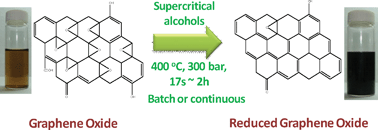A facile and green method to generate reduced graphene oxide nanosheets in supercritical alcohols had been developed.
Graphene has attracted much attention as a potential material for a wide range of applications due to its superior electrical, optical, chemical, mechanical, thermal and catalytic properties. In view of this, a large scale and cost effective method for the production of graphene is necessary in order for it to be used in industry. There are currently four different methods to synthesize graphene, the most promising of which is the chemical reduction route – but this method still has several limitations which hinder its use in commercial implementation.
Jaehoon Kim and coworkers from the Republic of Korea have developed a method to produce reduced graphene oxide (RGO) in supercritical fluids. This fast, facile and green route results in RGO with a high carbon-to-oxygen ratio, high electronic conductivity and high lithium storage capacity. This process is applicable for large scale production of RGO using a continuous flow-type reactor, providing opportunities for its production on industrial scale.
This article is free to access until the 30th September 2011! To read more, please see:
Facile synthesis of reduced graphene oxide in supercritical alcohols and its lithium storage capacity, Eduardus Budi Nursanto, Agung Nugroho, Seung-Ah Hong, Su Jin Kim, Kyung Yoon Chung and Jaehoon Kim, Green Chem., 2011, DOI: 10.1039/C1GC15678K











